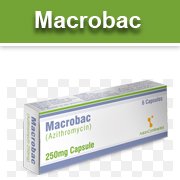
Macrobac – Pharmacokinetics
A large fraction of the absorbed dose of Macrobac remains un-metabolized. There is some metabolism in the liver mainly by N-demethytation, the metabolite being excreted in the bile. Trans-intestinal excretion of the unchanged drug is also an important route of elimination. Only a small amount of the dose is excreted unchanged in the urine.
Pharmacodynamics
Macrobac acts by binding to the 50S ribosomal subunit of susceptible microorganisms and thus, interferes with microbial protein synthesis. Nucleic add synthesis is not affected.
What Is Macrobac Used For?
Macrobac (Azithromycin) is active against both Gram Positive and Gram Negative organisms and is indicated for the treatment of infections caused by susceptible bacteria in conditions listed below:
Macrobac Indications
- Lower respiratory tract infections including bronchitis
- Pneumonia and acute bacterial exacerbation of chronic obstructive pulmonary disease
- Skin and soft tissue infections
- Upper respiratory tract infections including: sinusitis, pharyngitis, tonsillitis and otitis media
- Macrobac is also indicated in sexually transmitted diseases in men and women
Macrobac – Dosage and Administration
Since food reduces the absorption of Macrobac Capsules it should be given one hour before or two hours after meal.
Adults (including Elderly Patients)
For all other indications except sexually transmitted diseases, the total dose of 1.5g may be given as 500mg daily for 3 days. As an alternative, the same total dose can be given over 5 days with 500mg given on day 1, then 250mg daily on days 2 to 5. The recommended dose of Macrobac Capsules for the treatment of genital ulcer disease due to Haemophilus Ducreyi (Chancroid). Nongonococcal Urethritis and Cervicitis due to Chlamydia Trachomatis is: A single 1g (1000 mg) dose of Macrobac. The dose for the treatment of Urethritis and Cervicitis due to Neisseria Gonorrhoeae is single 2g (2000mg) dose of Macrobac.
Related Links
Leave A Comment